IL-4 directly signals tissue-resident macrophages to proliferate beyond homeostatic levels controlled by CSF-1
- PMID: 24101381
- PMCID: PMC3804948
- DOI: 10.1084/jem.20121999
IL-4 directly signals tissue-resident macrophages to proliferate beyond homeostatic levels controlled by CSF-1
Abstract
Macrophages (MΦs) colonize tissues during inflammation in two distinct ways: recruitment of monocyte precursors and proliferation of resident cells. We recently revealed a major role for IL-4 in the proliferative expansion of resident MΦs during a Th2-biased tissue nematode infection. We now show that proliferation of MΦs during intestinal as well as tissue nematode infection is restricted to sites of IL-4 production and requires MΦ-intrinsic IL-4R signaling. However, both IL-4Rα-dependent and -independent mechanisms contributed to MΦ proliferation during nematode infections. IL-4R-independent proliferation was controlled by a rise in local CSF-1 levels, but IL-4Rα expression conferred a competitive advantage with higher and more sustained proliferation and increased accumulation of IL-4Rα(+) compared with IL-4Rα(-) cells. Mechanistically, this occurred by conversion of IL-4Rα(+) MΦs from a CSF-1-dependent to -independent program of proliferation. Thus, IL-4 increases the relative density of tissue MΦs by overcoming the constraints mediated by the availability of CSF-1. Finally, although both elevated CSF1R and IL-4Rα signaling triggered proliferation above homeostatic levels, only CSF-1 led to the recruitment of monocytes and neutrophils. Thus, the IL-4 pathway of proliferation may have developed as an alternative to CSF-1 to increase resident MΦ numbers without coincident monocyte recruitment.
Figures

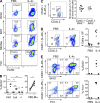
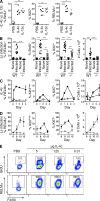
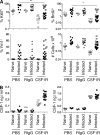
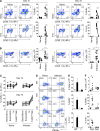
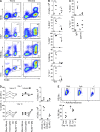
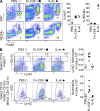
Similar articles
-
Dynamic changes in macrophage activation and proliferation during the development and resolution of intestinal inflammation.J Immunol. 2014 Nov 1;193(9):4684-95. doi: 10.4049/jimmunol.1400502. Epub 2014 Sep 26. J Immunol. 2014. PMID: 25261482 Free PMC article.
-
Macrophage dynamics are regulated by local macrophage proliferation and monocyte recruitment in injured pancreas.Eur J Immunol. 2015 May;45(5):1482-93. doi: 10.1002/eji.201445013. Epub 2015 Mar 19. Eur J Immunol. 2015. PMID: 25645754
-
Interleukin-4 receptor alpha signaling regulates monocyte homeostasis.FASEB J. 2022 Oct;36(10):e22532. doi: 10.1096/fj.202101672RR. FASEB J. 2022. PMID: 36063138 Free PMC article.
-
The twin cytokines interleukin-34 and CSF-1: masterful conductors of macrophage homeostasis.Theranostics. 2021 Jan 1;11(4):1568-1593. doi: 10.7150/thno.50683. eCollection 2021. Theranostics. 2021. PMID: 33408768 Free PMC article. Review.
-
Chronicity following ischaemia-reperfusion injury depends on tubular-macrophage crosstalk involving two tubular cell-derived CSF-1R activators: CSF-1 and IL-34.Nephrol Dial Transplant. 2016 Sep;31(9):1409-16. doi: 10.1093/ndt/gfw026. Epub 2016 Mar 24. Nephrol Dial Transplant. 2016. PMID: 27190368 Review.
Cited by
-
Isoliquiritigenin ameliorates caerulein-induced chronic pancreatitis by inhibiting the activation of PSCs and pancreatic infiltration of macrophages.J Cell Mol Med. 2020 Sep;24(17):9667-9681. doi: 10.1111/jcmm.15498. Epub 2020 Jul 17. J Cell Mol Med. 2020. PMID: 32678498 Free PMC article.
-
How Mouse Macrophages Sense What Is Going On.Front Immunol. 2016 Jun 2;7:204. doi: 10.3389/fimmu.2016.00204. eCollection 2016. Front Immunol. 2016. PMID: 27313577 Free PMC article. Review.
-
Macrophages: shapes and functions.ChemTexts. 2022;8(2):12. doi: 10.1007/s40828-022-00163-4. Epub 2022 Mar 10. ChemTexts. 2022. PMID: 35287314 Free PMC article.
-
Mouse Tissue-Resident Peritoneal Macrophages in Homeostasis, Repair, Infection, and Tumor Metastasis.Adv Sci (Weinh). 2023 Apr;10(11):e2206617. doi: 10.1002/advs.202206617. Epub 2023 Jan 19. Adv Sci (Weinh). 2023. PMID: 36658699 Free PMC article. Review.
-
IL4Rα Signaling Abrogates Hypoxic Neutrophil Survival and Limits Acute Lung Injury Responses In Vivo.Am J Respir Crit Care Med. 2019 Jul 15;200(2):235-246. doi: 10.1164/rccm.201808-1599OC. Am J Respir Crit Care Med. 2019. PMID: 30849228 Free PMC article.
References
-
- Alikhan M.A., Jones C.V., Williams T.M., Beckhouse A.G., Fletcher A.L., Kett M.M., Sakkal S., Samuel C.S., Ramsay R.G., Deane J.A., et al. 2011. Colony-stimulating factor-1 promotes kidney growth and repair via alteration of macrophage responses. Am. J. Pathol. 179:1243–1256 10.1016/j.ajpath.2011.05.037 - DOI - PMC - PubMed
Publication types
MeSH terms
Substances
Grants and funding
- G0600818/MRC_/Medical Research Council/United Kingdom
- MR/K01207X/1/MRC_/Medical Research Council/United Kingdom
- BB/H012559/1/BB_/Biotechnology and Biological Sciences Research Council/United Kingdom
- BBS/E/D/20251969/BB_/Biotechnology and Biological Sciences Research Council/United Kingdom
- 095831/WT_/Wellcome Trust/United Kingdom
LinkOut - more resources
Full Text Sources
Other Literature Sources
Molecular Biology Databases
Research Materials
Miscellaneous

